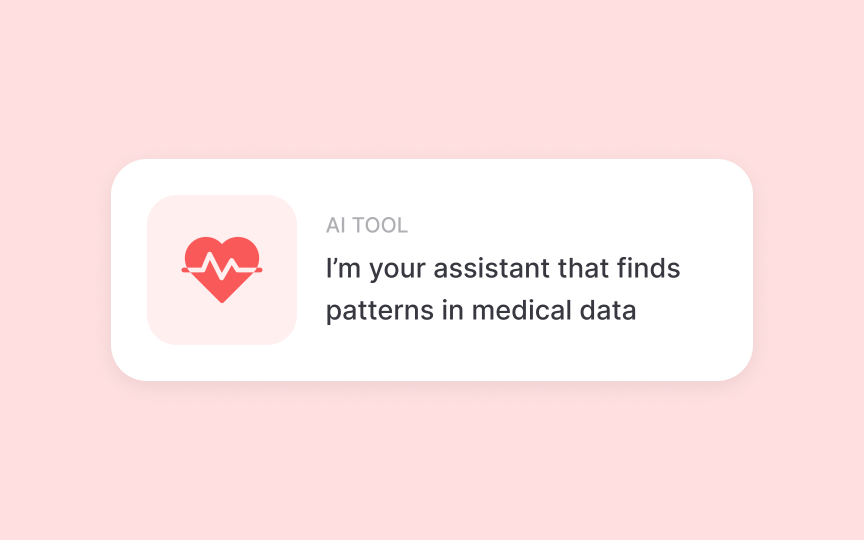Mental Models of AI
Understand how users conceptualize AI systems and why these mental models drive adoption and trust.
Mental models are the ideas people form in their minds about how things work. In AI, these internal assumptions shape how users interact with a system. They influence whether users trust it, how they use it, and if they come back to it over time. When users get frustrated with an AI tool, it's often because their expectations don't match what the system can actually do.
For example, if someone asks a chatbot a question it can't answer or feels unsure about a recommendation, their mental model is playing a role. The gap between what users expect and what the AI delivers creates friction, even if the system is technically advanced.
Designers can support users by understanding how these mental models are formed. People shape them through past experiences with technology, media, and cultural influences. When designers map out these patterns, they can spot common misunderstandings and address them.
Good AI interfaces help close this gap. They use clear onboarding, introduce features gradually, rely on familiar examples, and provide regular feedback. Over time, this helps users better understand what the AI can do and feel more confident using it. Shaping mental models in this way leads to more intuitive and trustworthy experiences that people want to use again.
Mental models represent the internal frameworks people construct to make sense of how systems work. With traditional interfaces, users develop relatively stable mental models through consistent design patterns. Buttons perform actions, menus contain options, and windows organize content.
Mental models matter significantly more in AI contexts precisely because they determine not just usability but appropriate trust. When users overestimate AI capabilities, disappointment follows. When they underestimate capabilities, valuable functionality goes unused. Most critically, inaccurate mental models lead to fundamental misunderstandings about what the system is doing with user data, why it makes certain recommendations, and where human oversight exists in the process.
Pro Tip: Start user research by asking participants to explain in their own words how they believe an AI system works. Their responses often reveal surprising assumptions and misconceptions.
Mental models for
Popular culture and media significantly shape expectations about AI capabilities. Science fiction portrays both utopian AI assistants and dystopian scenarios in which machines exceed human control. News coverage often amplifies breakthroughs while downplaying limitations, creating powerful but inaccurate expectations.
Users also build AI mental models through transfer from similar technologies. Someone familiar with search engines expects AI to retrieve information perfectly. Experiences with rule-based systems might lead users to assume AI never makes mistakes or follows consistent, programmed rules rather than learning from data. Social influences further shape mental models, as early adopters describe capabilities to others. Corporate marketing materials contribute by highlighting ideal scenarios while minimizing limitations. Even terminology like "artificial intelligence" versus "smart feature" triggers different expectations about system capabilities.
Pro Tip: When introducing new AI functionality, explicitly address the expectations users might bring from popular media portrayals of similar technology.
Users frequently develop misconceptions about
- General intelligence assumption. Users attribute comprehensive understanding and reasoning abilities to systems that actually process narrowly defined patterns. This leads to frustration when
chatbots miss contextual cues or recommendation engines suggest inappropriate items. - Consistency expectation. Users expect AI systems to provide identical answers every time, not recognizing that many systems incorporate randomness or continuously update based on new data. This becomes problematic in decision support contexts like medical diagnostics.
- Immediate learning belief. People often assume AI systems incorporate all feedback instantly. The reality that machine learning requires significant data and retraining cycles leads to frustration when immediate corrections don't change system behavior. Many users also expect transparent reasoning similar to human explanations from black box algorithms.
Pro Tip: Create an internal list of common misconceptions about your specific AI functionality and address each one through interface design.
The gap between users' expectations and
- Intelligence scope. Users often expect a comprehensive understanding across domains when systems actually excel only in narrow tasks. A language model might write impressive essays but fail at basic arithmetic, confounding users who expect uniform competence.
- Factual accuracy expectations. Users expecting perfect factual accuracy from generative AI encounter hallucinations that damage trust. This mismatch is particularly problematic in information-seeking contexts.
- Temporal understanding. AI systems often lack the ability to track conversational context over time, forgetting previous
interactions that users assume are remembered. This leads to frustrating repetition or contradictory responses. - Agency assumptions. Users frequently attribute more decision-making authority to AI than organizations intend. They might believe algorithmic recommendations represent final decisions rather than suggestions for human review, or conversely, might assume human oversight exists when automated systems operate independently.
Specialized research techniques help uncover the mental models users bring to
- Think-aloud protocols. Ask participants to verbalize their understanding of how the system works while completing tasks. Prompt users to explain why the system produced specific outputs and what information it might be using to reveal misconceptions not observable through behavior alone.[1]
- Mental model drawing exercises. Invite users to sketch or visualize how they believe the AI system works. Start with unstructured doodling where users freely represent their understanding, then move to structured mapping using standardized symbols for data flows, decisions, and interactions.[2]
- Expectation testing. Present users with hypothetical scenarios to probe their predictions about AI behavior. Ask "What do you think would happen if..." questions about unusual
inputs to reveal assumptions about system boundaries. - Spontaneous analogies. Listen for metaphors that users generate when describing AI systems. These provide rich insights into their underlying mental frameworks without direct questioning.
Pro Tip: During sketching exercises, encourage users to "think broadly" about connections between inputs and outputs, and reassure them there's no wrong way to represent their understanding.
Metaphors significantly influence how users understand
- Tool metaphors in product naming. Brand features with names like "Smart Filter," "Auto-Organize," or "Prediction Tool" instead of "AI Brain" or "Thinking Engine." These tool-based names set realistic expectations about system capabilities in product
marketing and UI. - System metaphors in user onboarding. Introduce AI functionality by explaining that it "searches through a vast library of patterns" rather than saying it "thinks about your request." These comparisons in tutorials help users form accurate mental models from the start.
- Natural metaphors in feedback messages. When an AI system improves with use, messaging like "Your feedback helps the system grow more accurate" reinforces an appropriate garden-like
mental model in error handling and improvement notifications. - Appropriate human-like qualities in interfaces. In conversational interfaces, a carefully balanced "assistant" metaphor might be appropriate, but avoid language suggesting the AI "feels," "wants," or "believes" in response text and help documentation.[3]
Pro Tip: Be consistent with your chosen metaphors across product copy, UI elements, marketing materials, and error messages to reinforce accurate mental models.
Well designed feedback helps users understand how
- Confidence indicators. Visual elements like confidence bars or labels such as "high confidence" or "speculative" help users know when to trust recommendations. These indicators show users when outputs might need double-checking.
- Source attribution. Showing where information comes from helps users understand AI outputs. When a movie recommendation system displays "Suggested because you watched X", users gain insight into the reasoning process.
- Processing signals. Animations showing the system working not only set timing expectations but also show that actual processing is happening. These visual cues make invisible AI operations visible and remind users of the system's mechanical nature.
- Error explanations. When AI systems make mistakes, clear explanations about why help users learn system limits. Statements like "Limited data available on this topic" teach users more about boundaries than vague apologies do.
Pro Tip: Show users not just what the AI can do, but also what it can't do to fix common misconceptions.
References
- Thinking Aloud: The #1 Usability Tool | Nielsen Norman Group
Top contributors
Topics
From Course
Share
Similar lessons

AI’s Role in Text Generation and Modification

Best Practices and Potential Pitfalls of AI Writing Tools




















